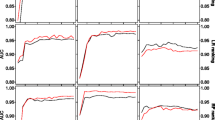Abstract
Bacterial vaginosis develops as a consequence of the displacement Lactobacillus producing lactic acid and hydrogen peroxide which protect the vaginal mucosa. A dataset consisting of 201 observations and 58 variables was tested. Apriori, Eclat, and FP-Growth algorithms created the association rules. Rules with statistical significance were selected with the quality metrics and the functions. Validation was performed to select biologically significant rules supported by the AWK programming language. The bacterial patterns presented by each algorithm when the dataset was balanced were of higher quality with respect to the patterns presented by each algorithm when the dataset was unbalanced. The algorithm with the lowest performance was Apriori. The Eclat algorithm performed well with respect to the number of rules reported. The FP-Growth algorithm performed well with respect to the quality of the reported pattern. Knowing the bacteria that these algorithms locate in the antecedent of the association rule is extremely important since this guides the physician objectively to attack the problem that bacterial vaginosis represents.
Access this chapter
Tax calculation will be finalised at checkout
Purchases are for personal use only
Similar content being viewed by others
References
Ravel J, Gajer P, Abdo Z, Schneider GM, Koenig SS, McCulle SL, Forney LJ (2011) Vaginal microbiome of reproductive-age women. Proc National Acad Sci 108(Supplement 1):4680–4687. https://doi.org/10.1073/pnas.1002611107
Onderdonk AB, Delaney ML, Fichorova RN (2016) The human microbiome during bacterial vaginosis. Clinical Microbiol Rev 29(2):223–238. https://doi.org/10.1128/CMR.00075-15
Bagnall P, Rizzolo D (2017) Bacterial vaginosis: a practical review. J Amer Acad PAs 30(12):15–21. https://doi.org/10.1097/01.JAA.0000526770.60197.fa
Morris M, Nicoll A, Simms I, Wilson J, Catchpole M (2001) Bacterial vaginosis: a public health review. BJOG 108(5):439–50. https://doi.org/10.1111/j.1471-0528.2001.00124.x
Gad GF, El-Adawy AR, Mohammed MS, Ahmed AF, Mohamed HA (2014) Evaluation of different diagnostic methods of bacterial vaginosis
Beverly ES, Chen HY, Wang QJ, Zariffard MR, Cohen MH, Spear GT (2005) Utility of Amsel criteria, Nugent score, and quantitative PCR for Gardnerella vaginalis, Mycoplasma hominis, and Lactobacillus spp. For diagnosis of bacterial vaginosis in human immunodeficiency virus-infected women. J Clinical Microbiol 43(9):4607-4612. https://doi.org/10.1128/JCM.43.9.4607-4612.2005
Kusters JG, Reuland EA, Bouter S, Koenig P, Dorigo-Zetsma JW (2015) A multiplex real-time PCR assay for routine diagnosis of bacterial vaginosis. Europ J Clinical Microbiol Infectious Diseases 34(9):1779–1785. https://doi.org/10.1007/s10096-015-2412-z
Sanchez-Garcia EK, Contreras-Paredes A, Martinez-Abundis E, Garcia-Chan D, Lizano M, de la cruz-Hernandez, E (2019) Molecular epidemiology of bacterial vaginosis and its association with genital micro-organisms in asymptomatic women. J Med Microbiol 68(9):1373–1382. https://doi.org/10.1099/jmm.0.001044
Zariffard MR, Saifuddin M, Sha BE, Spear GT (2002) Detection of bacterial vaginosis-related organisms by real-time PCR for Lactobacilli, Gardnerella vaginalis and Mycoplasma hominis. FEMS Immunol Med Microbiol 34(4):277–281. https://doi.org/10.1111/j.1574-695X.2002.tb00634.x
Baker YS, Agrawal R, Foster JA, Beck D, Dozier G (2014) Applying machine learning techniques in detecting bacterial vaginosis. In: 2014 International conference on machine learning and cybernetics, July, vol 1. IEEE, pp 241–246. https://doi.org/10.1109/ICMLC.2014.7009123
Beck D, Foster JA (2015) Machine learning classifiers provide insight into the relationship between microbial communities and bacterial vaginosis. BioData Mining 8(1):1–9. https://doi.org/10.1186/s13040-015-0055-3
Beck D, Foster JA (2014) Machine learning techniques accurately classify microbial communities by bacterial vaginosis characteristics. PloS One 9(2):e87830. https://doi.org/10.1371/journal.pone.0087830
Marchn E, Salcedo J, Aza T, Figuera L, de Pisn FM, Guillén P (2011) Reglas de asociacin para determinar factores de riesgo epidemiolgico de transmisin de la enfermedad de Chagas. Ciencia e Ingeniería 32(2):55-60. http://www.redalyc.org/articulo.oa?id=507550794009
Chausa Fernndez P, Gmez Aguilera EJ, Cceres Taladriz C, Garca Alcaide F, Gatell Artigas JM (2006) Extraccin de reglas de asociacin en una base de datos clnicos de pacientes con VIH/SIDA. https://oa.upm.es/13883/
Snchez O, Moyano JM, Snchez L, Alcla-Fdez J (2017) Mining association rules in R using the package RKEEL. In: 2017 IEEE International conference on fuzzy systems (FUZZ-IEEE), July, IEEE, pp 1–6. https://doi.org/10.1109/FUZZ-IEEE.2017.8015572
Hernndez JAR, Herrera DMR, Rodrguez JE (2016) A research comparative among association rules algorithms. Visin electrnica 10(2):7. https://doi.org/10.14483/22484728.11654
Mercaderes RD, Llavori RB (1996) Bsqueda de Reglas de Asociacin en bases de datos y colecciones de textos
Han J, Pei J, Yin Y (2000) Mining frequent patterns without candidate generation. ACM Sigmod Record 29(2):1–12
Zaki MJ, Parthasarathy S, Ogihara M, Li W (1997) New algorithms for fast discovery of association rules. In: KDD August, vol 97. pp 283–286
Heaton J (2016) Comparing dataset characteristics that favor the Apriori, Eclat or FP-Growth frequent itemset mining algorithms. In: SoutheastCon 2016, March, IEEE, pp 1–7
He H, Bai Y, Garcia EA, Li S (2008) ADASYN: adaptive synthetic sampling approach for imbalanced learning. In: 2008 IEEE international joint conference on neural networks (IEEE world congress on computational intelligence), June, IEEE, pp 1322–1328. https://doi.org/10.1109/IJCNN.2008.4633969
Borgelt C (2003) Efficient implementations of apriori and eclat. In: FIMI03: Proceedings of the IEEE ICDM workshop on frequent itemset mining implementations, November, pp 90
Hahsler M, Buchta C, Hornik K (2008) Selective association rule generation. Computat Stat 23(2):303–315
Hornik K, Grn B, Hahsler M (2005) Arules-a computational environment for mining association rules and frequent item sets. J Stat Softw 14(15):1–25. https://doi.org/10.18637/jss.v014.i15
Aho AV, Kernighan BW, Weinberger PJ (1979) Awk-a pattern scanning and processing language. Softw: Pract Exper 9(4):267–279
Author information
Authors and Affiliations
Corresponding author
Editor information
Editors and Affiliations
Rights and permissions
Copyright information
© 2023 The Author(s), under exclusive license to Springer Nature Singapore Pte Ltd.
About this paper
Cite this paper
Ruiz, F.d.l.C., Reich, J.C. (2023). Apriori, Eclat, and FP-Growth Algorithms to Study Bacterial Vaginosis. In: Kumar, S., Hiranwal, S., Purohit, S., Prasad, M. (eds) Proceedings of International Conference on Communication and Computational Technologies. ICCCT 2023. Algorithms for Intelligent Systems. Springer, Singapore. https://doi.org/10.1007/978-981-99-3485-0_79
Download citation
DOI: https://doi.org/10.1007/978-981-99-3485-0_79
Published:
Publisher Name: Springer, Singapore
Print ISBN: 978-981-99-3484-3
Online ISBN: 978-981-99-3485-0
eBook Packages: Intelligent Technologies and RoboticsIntelligent Technologies and Robotics (R0)




